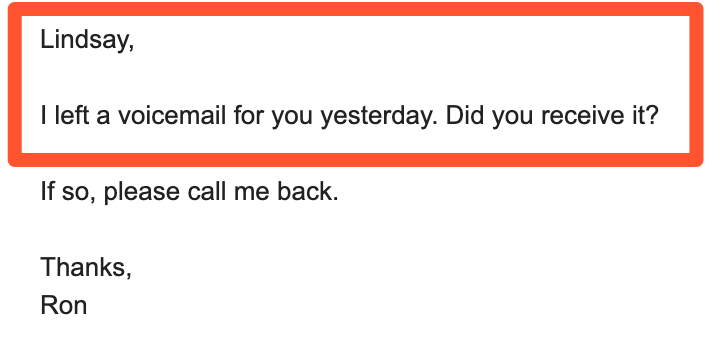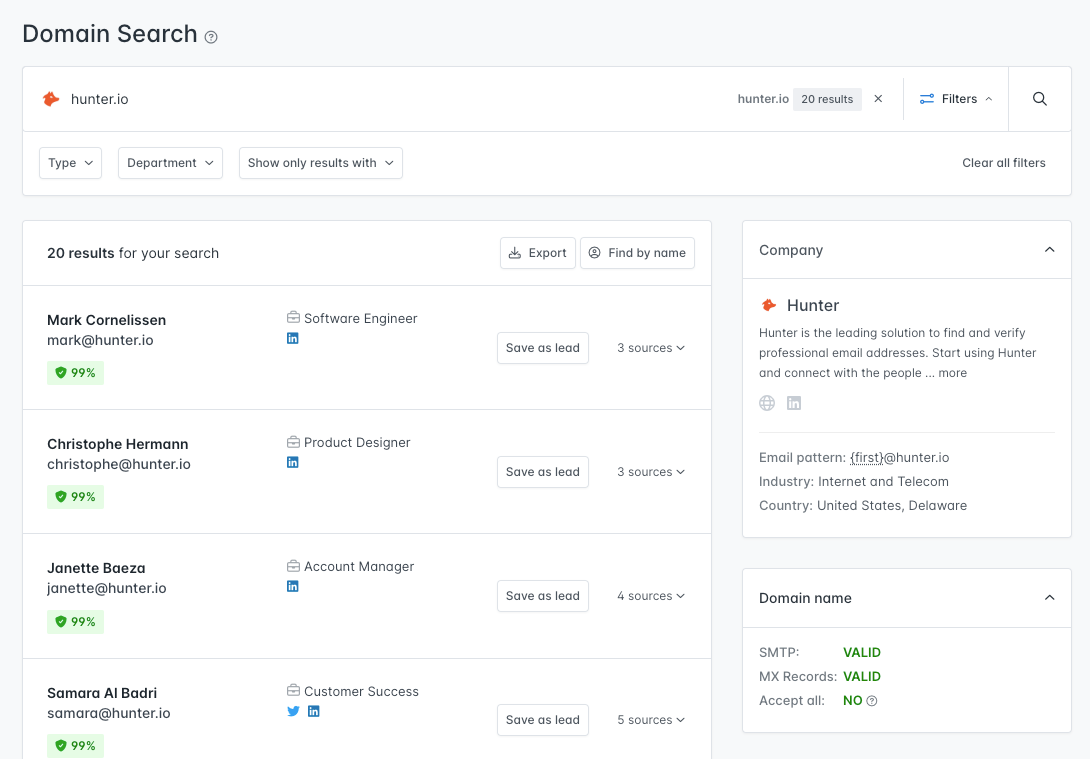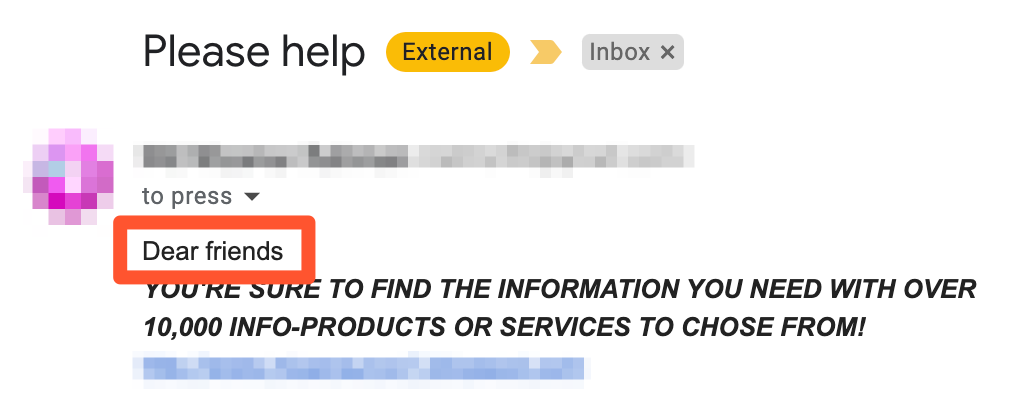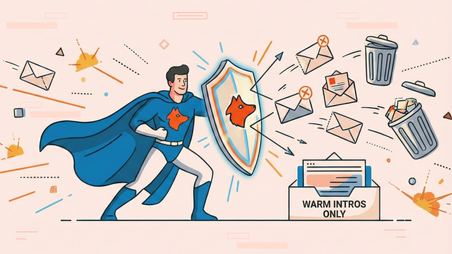How to Start an Email (7 Opening Ideas and Tips)

How you start an email has a big impact on how that email is perceived and how its recipient responds. Go too casual, and your recipient might think less of you, your position or your offer. Go too formal and they might feel like you’re stiff and stuffy. Go too salesy and you might turn them off, but if you aren’t salesy enough, they might miss your offer….you get the idea.
When you’re stuck on how to start an email, remember this: the best way to start an email depends on what you’re trying to achieve with that specific email.
An email opening that’s too salesy for a first-contact cold email might be the perfect way to kick off an email introducing a warm audience to your latest offering. But there are a few key elements that every effective email opening shares, and those are:
- An engaging greeting
- A strong hook
Starting an email off the right way boosts the likelihood that your recipient will take the action you want them to take. It can also increase your future emails’ open rates by demonstrating that emails from your brand deliver high quality content. Once people know your emails are worth opening, they’ll make sure to open them every time.
How to Start an Email: Anatomy of an Email Opening
An email opening has two parts: the greeting and the opening line. In some cases, the greeting can extend past the opening line and into the next sentence or two, but it never extends beyond the email’s first paragraph.
Greeting
Every email begins with a greeting. This is where you address your recipient directly, and it’s where you can potentially connect with them or lose the connection instantly, depending on the greeting you choose.
Common greetings for emails include:
- Hi [recipient name]
- Dear [recipient name]
- Hello [recipient name]
- Greetings [recipient name]
Sometimes, emails start with just the recipient’s name. For example:

This kind of greeting is very direct and can be interpreted as condescending or rude. We don’t suggest it for cold emails, but within certain companies, this is the standard way for colleagues to communicate with each other. Whether this type of greeting is appropriate for interpersonal emails or not depends on the company’s culture.
Opening Line
This is where you hook your reader. In emails, hooking your reader means grabbing their attention and building their interest in a way that makes them want to read your entire message. Effective emails are brief emails, so your opening line should get right to the point. Here are a few examples of successful opening lines:
- You probably get this often, but your background caught my eye
- Unfortunately, I couldn’t get in touch with you on the phone earlier today. I was calling to discuss [brief description of the offer]
- I hope all is well with you
- Hope your week is off to a great start
- Hope you had an amazing weekend
As you can see from these examples, it’s not uncommon for a business email—as well as lots of informal greetings—to many emails start with some variation of “I hope all is well with you.” This is a common way to make an email feel more friendly and make a good impression on the recipient, which is why it’s commonly used in interpersonal emails. However, it’s not a popular choice for cold emails because in these, this kind of greeting can potentially feel too familiar.
Use it when you have an existing relationship with the recipient and it feels appropriate to greet them this way. In other words, if it’s something you would say to the recipient face-to-face, it can work as part of your email opening. Otherwise, get directly to the point.
Effective Openings that Work
There’s one thing that separates effective greetings from ineffective ones: personalization.
That doesn’t mean that a personalized greeting automatically means a successful email; plenty of personalized emails have low conversion rates because they have other issues going on. Personalizing the emails you send is the bare minimum of sending a successful cold email.
So what does an effective, personalized email greeting look like? That all depends on your email’s purpose. If you’re emailing to communicate how your product or service resolves a specific pain point for the recipient, an effective greeting might look like this:
When your goal is to connect a recruiter with the ideal employee for their posted job opening, the most effective email opening to use might be something like:
You can find inspiration for just about any kind of email opening in our vast Hunter Templates library.
Customizing large batches of cold emails is easy with Hunter Campaigns. Just collect your list of prospects (hint hint: tools like Email Finder and Domain Search make this waaaaay easier).
For example, with Domain Search, you'll just need to enter a company domain, and you'll get the list of the people who work for that company with their emails, positions, and social media profiles.

Add your prospects’ email addresses to CSV and upload it into Hunter Leads (a simple CRM tool that allows you to structure information about your prospects).
Note: If you use Hunter to find your prospects’ email addresses, there is no need to create a CSV file—you can save this info directly to Leads.


Use the data from CSV/Hunter Leads to personalize emails in bulk automatically.

Greetings to Avoid
Above, we mentioned that starting an email with just the recipient’s name is usually a bad move. But that’s not the only kind of greeting you’re best off avoiding. Others include:
- To whom it may concern. This greeting feels cold and impersonal—almost as if you’re sending an email you don’t have any actual interest in sending.
- Dear sir/madam. With this greeting, you make it clear that you have no idea who the recipient is. In today’s era of cold email personalization, you can personalize your emails easily... and even when you don’t know the recipient’s name, there are better alternatives to use, like addressing them by their job title.

- Dear friend. While a level of familiarity can be useful in informal greetings, referring to an email recipient as “dear friend” comes across as a weird mix of formal and familiar. The “dear” implies formality, while the “friend” implies a close relationship—but if you actually have a close relationship, you’d be addressing the recipient by name. This greeting and variations on it, like “Hi friend,” and “Dear recipient” just feel strange.

And then there are a few phrases that should never be part of your opening line. These include:
- Apologies. If you’re emailing to apologize for a legitimate mistake on your part, do so after the opening line. In any other email, starting off with an apology (for spamming their inbox, for wasting their time, for not reaching out sooner, etc) makes it look like you feel guilty and starts your conversation off on a negative note.
- A startling fact or statistic. Even if it’s relevant to your email’s purpose, positioning it like this can make your email feel like more of an essay or a sales pitch than a communication.
- Any point that’s irrelevant to the email or otherwise detracts from its main message. For example, if your email is to announce a new feature on your website, don’t start it off with a promo code that’s only valid for the next 24 hours. By doing this, you’re buying the lede; downplaying the email’s primary message by obscuring it in less important information.
What About the Subject Line?
Every email you send has a subject line. Even though this is the first part of your email the recipient sees, it’s not technically part of your email opening. It’s a unique component that plays a substantial role in whether the recipient opens your email. As such, you’ve got to write subject lines that convert.
How?
There are lots of ways to optimize your cold email subject lines for higher conversions. We wrote a whole blog post about effective cold email subject lines that you can customize for your brand and the specific emails you send. A lot of work goes into writing an effective subject line and generally, the most effective ones are:
- Personalized to the recipient
- Short
For a follow-up email, the same principles apply, but there are a few key strategies that work best for follow-ups compared to the initial emails you send.
As you brainstorm subject lines, think about how they’ll work with the first few lines of your email. Many email providers display email snippets, the first sentence or two of an email, before the recipient even opens the message.
To Personalize or to Not Personalize?
As we mentioned above, the answer is yes, you need to personalize your email openings. And Hunter Campaigns makes it incredibly easy to build personalized email sequences. In fact, there’s no reason not to personalize your emails—not personalizing them only reflects poorly on your brand and your offer and makes recipients less likely to continue engaging with you.
Personalization goes beyond addressing your email recipients by name. Using Hunter’s tools and templates, you can mention specific companies, colleagues, events, and even competitors in the emails you send. Within seconds of opening your email, your reader can tell whether it’s a generic pitch or a personalized message crafted specifically to engage with them. Start each relationship off on the right foot by sending emails that spark conversations, not emails that feel like the digital version of junk mail.
Take a look at these personalized email examples to see just a few of the many ways you can automate your cold email personalization:
What if I Don’t Know the Recipient’s Name?
You might run into a situation where you don’t know the recipient’s name. What do you do?
You’ve probably heard before that it’s perfectly fine to start your email with “Dear Hiring Manager,” “Dear Editor,” or some variation of these. It is—when you have no other option.
But that should be your last resort. Before starting your email with this kind of greeting, do everything you can to find the recipient’s name. A few strategies you can use include:
- Google the email address and see if there's a person's name mentioned in the results. Similarly, you can search for the email address on LinkedIn and other social media platforms.
- Guess the recipient’s name from the email pattern. For example, if the email address is irina@hunter.io, it's obvious that the recipient's name is Irina. If the email address follows the first.last@domain.com or another pattern like this, you can extrapolate at least part of the recipient’s name from the address. Even if you can only determine their last name and need to greet them as Mr./Ms. Lastname, this is better than a generic greeting.
- If you use Domain Search to find email addresses, you'll get a full name of your prospect for each email address found.
Choosing the Right Opening for your Recipient
Earlier, we mentioned that you should personalize every cold email you send and craft an opening that communicates directly to the problem you’re trying to solve for the recipient or the goal you’re trying to achieve with them. Those are the first two components of crafting an effective opening.
The third component is striking the perfect tone for your email. You establish your whole email’s tone in your opening, and getting the tone just right plays a huge role in whether your email converts (or not). Compare these two email openings to see two different tones in action:
See how the second email opening just feels more casual than the first one, like it’s a coworker casually dropping by your desk versus a new contact reaching out after meeting for the first time? Both emails were crafted to communicate the appropriate tone for the situation they’re used for.
So how do you determine the right tone for your email? Ask yourself the following:
- What is my relationship with the recipient? Is this the first cold email they’ve ever received from me, or is it a follow-up or part of a series?
- Who am I sending this email to?
- What am I offering in this email?
- What am I asking from the recipient? Do I want an email back, a registration, a purchase, or something else?
- What is my brand persona?
- How familiar is the recipient with my brand?
Then, imagine that the email you’re writing is a face-to-face conversation between you and the recipient. How would you speak to them? This is your tone. Your tone can be casual, formal, or somewhere in between.
And then once you’ve determined the right tone, how do you communicate it? Your word choices and grammatical style—and this includes deliberately breaking grammar rules for stylistic reasons—direct how your reader interprets the message. Take a look back at the examples above. They both address the recipient by their first name, but one greets them with “hi” and the other greets them with “hey.” Over at the opposite end of the formality spectrum from “hey,” we have “dear.” Take a look at an email that starts with “dear”:
When your email needs to feel professional or otherwise formal, “dear” is how you do it. When it’s a casual message that assumes familiarity between the recipient and your brand, “hey” can be the perfect greeting. And when your email’s tone needs to fall somewhere between the two, “hi” or “hello” are your best bets.
Start Every Email Off Right
A strong email opening is just the beginning of a great email. It sets the tone and makes the initial connection, but it’s just one part of an email that builds engagement and converts. Once you’ve made your connection, your email’s got to deliver a valuable message or offer, then end in a way that seals the deal and encourages the reader to keep the conversation going. For help with that last part, check out our guide to how to end an email.
Want to see how these three components work together in any kind of email? Check out Hunter Templates. Learn how to write effective cold emails by seeing them in action and dissecting how they work to understand why they work so well.




 Send cold emails with Hunter
Send cold emails with Hunter